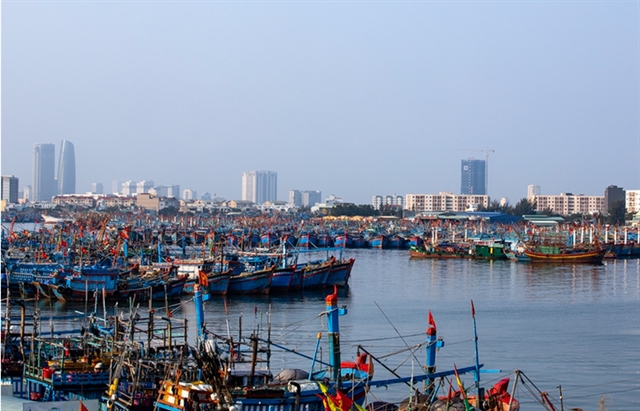 |
| Fishing port systems and shelter areas are planned by 2030. VNA/VNS Photo |
HÀ NỘI – Deputy Prime Minister Trần Lưu Quang has signed a decision to approve the planning of a maritime port system and storm shelter areas for fishing boats.
According to the plan, ports and storm shelter areas for fishing boats are identified as critical components of the fishery sector infrastructure, both economically and socially.
They are considered one of three strategic breakthroughs, requiring investment to ensure efficient fishery exploitation, economic and social development and social security, while improving the material and spiritual life of the people.
The plan, for the period 2021 – 2030, with a vision to 2050, is all part of work to modernise the fishing industry infrastructure, to better meet the needs of logistics services and ensure food hygiene and safety.
It should reduce post-harvest losses and guarantee the safety for fishing vessels and fishermen, as well as improve the effectiveness of fisheries management, enhance international integration, adapt to climate change and protect the environment and marine ecosystem and contribute to ensuring national defence and security.
The specific goal is that by 2030, there will be a complete system of ports under effective operation and storm shelters for fishing vessels on a nationwide scale.
The industrialised and modernised system needs to meet the needs of anchorage, fisheries logistics services and has to be developed in an integrated direction, increasing the value of exploitation.
The fishing port system ensures a throughput of 2.98 million tonnes of seafood per year (including 100 per cent of exploited seafood output and a part of marine aquaculture output), ensure the implementation of fisheries management, meeting the requirements for tracing the origin of exploited aquatic products and preventing illegal fishing activities.
The system of shelters for fishing vessels ensures that over 83,600 fishing vessels will be able to safely anchor and be protected from storms.
All fishing ports and shelter areas must be allocated land and water use according to Articles 78 and 84 of the 2017 Fisheries Law.
Additionally, key domestic and international trade hubs will be set up to drive the development of fishery industrial zones, coastal economic zones and major fishing centres linked to key fishing grounds, enhancing the fishery sector’s efficiency and sustainability.
Infrastructure and capacity of fishing ports will be improved to meet the needs of fisheries logistics, ensure food safety and hygiene and integrate economic development, tourism, culture, society, environmental sanitation, new rural construction and national defence and security in appropriate places.
All type I fishery ports in major fishing centres to be built with complete, modern infrastructure with 90 per cent mechanised cargo handling systems.
All type II fishery ports to have synchronised infrastructure with 70 per cent mechanised cargo handling systems.
Digital management
From the period 2021 – 2025, the plan will focus on completing the infrastructure of type I fishing ports at five major fishing centres and storm shelters for regions where most vessels are frequently anchored, fishing port projects and storm shelters for fishing vessels on islands and projects associated with national defence and security.
By 2050, a modern, comprehensive fishery port system comparable to major ports globally will be developed meeting green port criteria, with type I fishery ports in major fishing centres acting as international gateways and key links in the global fishery value chain, with high competitiveness.
According to the plan, the five major fishing centres will be developed in: Hải Phòng City linking to the Gulf of Tonkin fishing ground in Lập Lễ and Thủy Nguyên districts; Đà Nẵng linking to the East Sea and Hoàng Sa fishing ground in Thọ Quang Ward, Sơn Trà District; Khánh Hòa Province connecting to the South Central Coast and Trường Sa fishing ground in Cẩm Linh Ward, Cam Ranh City; Bà Rịa – Vũng Tàu Province linking to the Southeast Coast fishing ground in Long Sơn Commune, Vũng Tàu City; and Kiên Giang Province linking to the Southwest Coast fishing ground in Tây Yên A Commune, An Biên Sistrict, and Bình An Commune, Châu Thành District.
By 2030, the country should have 173 fishery ports, including 39 type I, 80 type II, and 54 type III ports, with a total capacity of 2.983 million tonnes of fishery products annually and 160 storm shelter areas for fishing boats, including 30 regional and 130 provincial-level shelters, with harbour space for about 90,600 fishing boats.
Spending on the plan will come from central and local budgets and private investment. VNS
- Reduce Hair Loss with PURA D’OR Gold Label Shampoo
- Castor Oil Has Made a “Huge” Difference With Hair and Brow Growth
- Excessive hair loss in men: Signs of illness that cannot be subjective
- Dịch Vụ SEO Website ở Los Angeles, CA: đưa trang web doanh nghiệp bạn lên top Google
- Nails Salon Sierra Madre
 VnExpress News The News Gateway of Vietnam
VnExpress News The News Gateway of Vietnam





